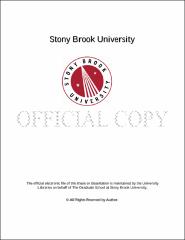| dc.identifier.uri | http://hdl.handle.net/11401/77664 | |
| dc.description.sponsorship | This work is sponsored by the Stony Brook University Graduate School in compliance with the requirements for completion of degree. | en_US |
| dc.format | Monograph | |
| dc.format.medium | Electronic Resource | en_US |
| dc.language.iso | en_US | |
| dc.publisher | The Graduate School, Stony Brook University: Stony Brook, NY. | |
| dc.type | Thesis | |
| dcterms.abstract | Synchrotron X-ray diffraction is used to investigate mineral structures. Accurate analysis of the results is limited by intensity errors caused by the experimental setup, sample, and detector. These include high intensity spikes, dead pixels, beam stop shadow, single crystal spots, and poor powder statistics, and they all contribute to the background uncertainty within powder diffraction datasets. The errors must be either quantified or removed. Due to the intrinsically low peak-to-background ratios of measured intensities in experiments at non-ambient conditions, the intensity errors are usually overestimated in subsequent Rietveld refinement; leading to unrealistically low uncertainties in the refined structural parameters. FIT2D, the commonly used tool for synchrotron X-ray diffraction data processing, does not have methodology to solve some of these problems, and masking data is ordinarily manual and tedious. Our program automatically masks and addresses the data analysis problems by examining intensity uncertainties. In the program, data is sorted by two-theta value into bins during the integration process. The contents of individual bins are then statistically analyzed. The data is assumed to be Poisson distributed, and intensity values outside a user-specified interval of the standard deviation are rejected. The data is then normalized to account for variance in the number of pixels contributing to a particular measurement. The final software modules will be collected in a code repository and used for the data acquisition and analysis software package at the X-ray Powder Diffraction (XPD) beamline at NSLS-II. | |
| dcterms.available | 2017-09-20T16:53:15Z | |
| dcterms.contributor | Ehm, Lars | en_US |
| dcterms.contributor | Liebermann, Robert | en_US |
| dcterms.contributor | Reeder, Richard. | en_US |
| dcterms.creator | Sims, Melissa | |
| dcterms.dateAccepted | 2017-09-20T16:53:15Z | |
| dcterms.dateSubmitted | 2017-09-20T16:53:15Z | |
| dcterms.description | Department of Geosciences. | en_US |
| dcterms.extent | 55 pg. | en_US |
| dcterms.format | Monograph | |
| dcterms.format | Application/PDF | en_US |
| dcterms.identifier | http://hdl.handle.net/11401/77664 | |
| dcterms.issued | 2014-12-01 | |
| dcterms.language | en_US | |
| dcterms.provenance | Made available in DSpace on 2017-09-20T16:53:15Z (GMT). No. of bitstreams: 1
Sims_grad.sunysb_0771M_12049.pdf: 2611339 bytes, checksum: c9f79ecc8d27829238f4bc5424bd2153 (MD5)
Previous issue date: 1 | en |
| dcterms.publisher | The Graduate School, Stony Brook University: Stony Brook, NY. | |
| dcterms.subject | Mineralogy | |
| dcterms.subject | Powder Diffraction, Synchrotron | |
| dcterms.title | Beyond FIT2D: Calculating Intensity Errors for Data Analysis of X-Ray Synchrotron Powder Diffraction Data | |
| dcterms.type | Thesis | |

